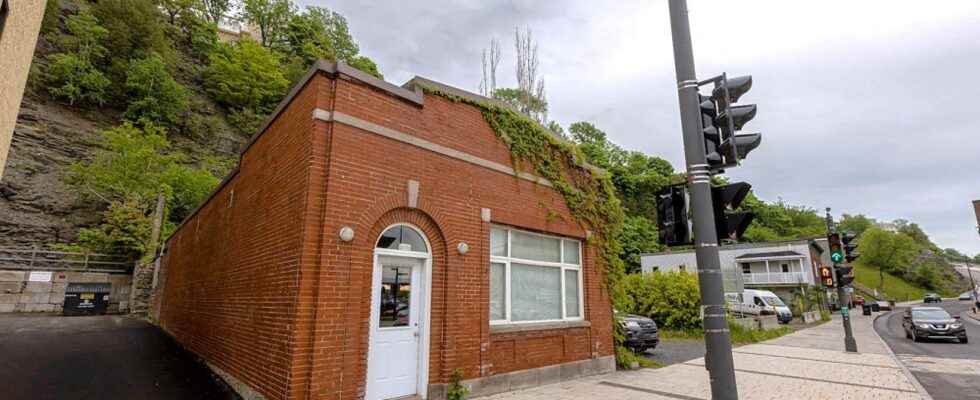A mechanical link envisaged in Lévis could not only make it possible to climb a cliff, but also to go back to the history of New France. Archaeologists have exhumed, at the very place where the elevator must come out of the ground, bones belonging to a European who died in the 16th century.e century. An “extremely rare” discovery, made on land that may not yet have revealed all of its secrets.
It was purely by chance that these human remains resurfaced in 2015. Hydro-Québec was then carrying out burial work at the foot of the cape overlooking Saint-Laurent Street in the crossing sector. Archaeological monitoring carried out as part of this project has led to the exhumation of a few finds, including small human bones that predate the founding of Quebec by Samuel de Champlain in 1608.
These bones correspond to the “tibiae, fibula, talus, calcaneus, tarsi and phalanges” of a European who died in 1587, according to carbon-14 dating carried out by the University of California. The excavation report, of which The duty obtained a copy, specifies that “the individual was buried at a shallow depth, possibly in a hurry, without clothing or furniture, which makes identification even more complex”.
Searches conducted in 2015 and 2016 did not reveal the presence of a coffin.
Without any trace of nails, planks or metal parts, impossible, in the current state of research, to know “definitively” the mode of burial which was used to bury the person, whose sex also remains undetermined.
Who was this dead man, buried hastily on the banks of the St. Lawrence at a time when Europeans were not legion to criss-cross New France?
Basque fisherman or French sailor
The remains could be those of a Basque fisherman, says historian and professor emeritus at Laval University Denys Delâge. “The Basques came here at the end of the 16the century to hunt whales and trade with the Amerindians in Tadoussac,” he explains. The discovery of remains dating back to the beginnings of New France is “extremely rare”, according to Mr. Delâge.
“European bones dating from this period, we could find as far as Trois-Rivières. It has never been done, but it would be possible, ”underlines the professor. If the remains do indeed belong to a Basque fisherman, it is the southernmost burial ever discovered in Quebec.
The dead could also have belonged, during his lifetime, to the crew of Jacques Noël, the nephew of Jacques Cartier, according to archaeologist Yves Chrétien.
“We know he came. [Il] had been granted exclusive rights to exploit the St. Lawrence Valley in 1588,” explains the researcher.
The Biographical Dictionary of Canada mentions that “Jacques Noël knew Canada well, having come there at least in 1585”. He had, during this trip, reached the rapids of Hochelaga and climbed Mount Royal to “pierce the mystery of the horizon”, indicates the dictionary.
Jacques Noël then returned to Europe, having uprooted an Aboriginal to exhibit it in France, following a mania of the time. The two sons of the Malouin, Jacques and Michel, in turn sailed on the St. competing caterers,” the dictionary continues. Pataches, small boats, were used at the time to travel the river.
Additional research in the area could shed more light on the identity of the individual and the context of his death, according to Daniel Castonguay, whose firm carried out the excavations in 2015. Regardless of who it is, the discovery of these bones is a rarity with promising potential.
“Anything European in this time frame is so rare,” enthuses archaeologist Yves Chrétien. We are after Jacques Cartier and before Samuel de Champlain. It’s very, very poorly documented. »
More excavations to come
Hydro-Québec carried out excavations in the furrow necessary for its work. Since the exhumation of the bones, no one has returned the earth to unearth other possible discoveries.
“The entirety of the potential remains of this area is assured since no work has[ont] been realized[s]since, at this location,” indicates the City of Lévis.
A controversial project could, however, change the situation. The administration of Mayor Gilles Lehouillier dreams of installing a ski lift in the area to facilitate access to businesses located at the top of the cliff. The elevator must climb the cape precisely where the bones rested, that is to say on the grounds facing the old post office.
A building “of heritage value considered [comme] forte” will also have to fall under the peak of the demolishers in the wake of the project. The one-storey red brick building dates from 1927. It belonged to individuals before the City expropriated them and acquired the building for $763,000.
Merchants and citizens denounce the place favored by the City to build the ski lift. They say that once they reach the top, at the tip of rue Marie-Rollet, people will still have to strain to reach the shops located 350 meters away. Another imposing hill will stand on the road for the adventurous who want to shop in Lévis.
The City, however, persists and signs, convinced that the site has all the assets for the lift to become a signature attraction in the landscape of Lévis. A belvedere must offer, at the top of the elevator, one of the most beautiful views of the river and Quebec.
The Town Hall claims to have “always intended to continue the excavations, considering the archaeological value of the place. This element will therefore be integrated into the planning of all future projects in the area where the bones were found”.
The call for proposals for the ski lift ended Friday at 3 p.m. At the time these lines were written, it was impossible to know the number of bidders who had expressed interest. “A few days will be necessary to follow up,” the city said in writing.
With Dave Noel
